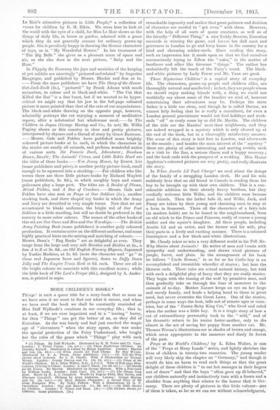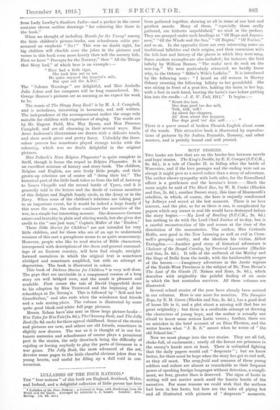MORE CHILDREN'S BOOKS..
Things ° is such a queer title for a story-book that as soon as we have seen it we want to find out what it means, and when we have read the book we shall be constantly reminded of Miss Dolf Wyllarde's creations in our everyday life ; that is, at least, if we are ever impatient and in a " tearing " hurry, for then " Things " can get the better of us, as they did of Ernestine. As she was lonely and had just reached the magic age of " eleventeen " when the story opens, she was under the special protection of the Fairy Understand, who taught her the rules of the game which " Things " play with such
*
(1) This:gr. By Dolt Wyllarde. Illustrated by B. M. Peirce and Ch. Vane, London : T. Fisher trnwin. [5e. net.]—(2) Those Mysterious Children. By Dorothy Russell. Illustrated Iii. Colour by Honor Appleton. London : Blackle and Son. (8e. Od.]—(3) When Auntie Lit Took Charge. By May Wynne. Illustrated by A. A. Dixon. Same publishers. (25.1—(4) Tell•Me-W Ad Stories about Animals. By C. H. Cloudy. With 8 Illustrations by Thomas Wrenn. London : George Harrap and Co. [Ss. 6d. nct.]—(6) Peeps at the World': Children. By L. Edna Walter, B,So., A.C.G.S. With 22 Full-page Illus- trations, 12 being in Colour. London A. and 0. Black. [le. (1d. net.)—(6) Mores for the Young. By Marcus. Illustrated by George Morrow. With a Foreword by, William Locke. London : John Lane. (2s. net.]—(7) The Sleepy Song Book. Music by II. A. J. Campbell. Words by Eugene Field, May Byron, and Florence Campbell. Pictures by Anne Anderson. London : George Harrap and Co. (6s. net4---(8) More Belgian Playmates : a Second Story of the Great European War. Ily Nciiis Pollock. With 5 Illustrations by. G. P. Carruthers. London : Gay and Hanzock. [Is. 6d. net.]—(6) Bible Stories or Children. London : T. Nelson and Boils, L25.j--(10) Dsckmu Stories Jor Children. time publIslicre. [211-]
remarkable ingenuity and malice that great patience and decision of character are needed to " get even " with them. However, with the help of all sorts of queer creatures, as well as of the friendly " Different Thing," a nice Teddy-Bearess, Ernestine succeeds in winning the game, and leaves her dull aunt and governess in London to go and keep house in the country for a kind and charming soldier-uncle. Since reading this story, such an impression has it made upon us that we find ourselves unconsciously trying to follow the " rules," in the matter of bootlaces and other like tiresome " things." The author has undoubtedly felt the touch of the Fairy's wand. The black- and-white pictures by Lady Poirse and Mr. Vane are good.
Those Mysterious Children2 is a capital story of everyday life. The characters, grown-up people and children alike, are thoroughly natural and unaffected ; in fact, they are people whom we should enjoy making friends with, a thing we could not truthfully say about some of the families we read of, however entertaining their adventures may be. Perhaps the stern father is a little too stern, and though he is called Doctor, we cannot help feeling that he is really a consultant, for even a London general practitioner would not find holidays and week- ends " off " so easily come by as did Dr. Martin. The children of the title are the Martins' next-door neighbours, and they are indeed wrapped in a mystery which is only cleared up at the end of the book, but in a thoroughly satisfactory manner. The scene of this story is laid first in London, and afterwards at the seaside ; and besides the main interest of the " mystery " there are plenty of other, interesting and moving events, such as a visit to the Zoo, a serious illness and a happy recovery ; and the book ends with the prospect of a wedding. Miss Honor Appleton's coloured pictures are very pretty, and really illustrate the story.
In When Auntie Lil Took Charge we read about the doings of the family of a struggling London clerk. Re and his wife suddenly hear that an old friend in Canada is sending them his boy to be brought up with their own children. This is a con- siderable addition to their already heavy burdens, but they cordially welcome little Willie, and the children soon become good friends. Then the father falls ill, and Willie, Jack,, and Pansy are taken by their young and charming aunt to stay at a farm in Somerset. There all the characters of a fairy-tale (in modern habit) are to be found in the neighbourhood, from an old witch to the Prince and Princess, really of course a young soldier and the squire's daughter. All these people, including Auntie Lil and an artist, and the farmer and his wile, play their parts in a lively and exciting manner. There is a coloured frontispiece and a few black-and-white illustrations.
Mr. Claudy takes us into a very different world in his Tell-Me- Why Stories about Animals.° He writes of men and Leasts with sympathy and understanding, and draws vivid pictures of jungle, forest, and plain. In the arrangement of his book ho follows " Uncle Remus," in so far as his Carlie-boy is an accomplished and irresistible wheedler of stories ; but here the likeness ends. These tales are actual natural history, but told with such a delightful play of fancy that they are really stories. They begin with the taming of the wolf by primitive man, and then gradually take us through the time of monsters to the animals of to-day. Mother Nature keeps art eye on her large and unruly family, and lends a helping hand to those in great need, but never overrules the Great Laws. One of the stories, perhaps in some ways the best, tells not of remote ages or coun- tries, but of the " Foster-Baby King Cat," who lived and ruled when the author was a little boy. It is a tragic story of how a cat of extraordinary personality took to the " wild," and of his dramatic return to his terrier foster-mother, only to die almost in the act of saving her puppy from another cat. Mr. Thomas Wrenn's illustrations are in shades of brown and orange, which seem appropriate to the immense and dimly lit forest of the past.
Peeps at the World's Children,' by L. Edna Walter, is one of the " Peeps at Many Lands " series, and lightly sketches the lives of children in twenty-two countries. The young reader will very likely skip the chapter on " Germany," and though it would do him no harm to read such things as that the great delight of these children is " to eat hot sausages in their fingers out of doors " and that the boys " often grow up ill-behaved," our children naturally and instinctively turn with a frown and a shudder from anything that relates to the horror that is Ger- many. There are plenty of pictures in this little volume--ena of them is taken, as far as we can see without acknowledgment,
from Lady Lawley's Southern India—and a pocket in the cover contains eleven outline drawings " for colouring like those in
the book."
When we thought of including Morals for the Young' among the little children's picture-books, one schoolroom critic pro- nounced an emphatic " No ! " This was no doubt right, for big children will chuckle over the jokes in the pictures and verses in this book even more keenly than will the nursery folk. First we have " Precepts for the Nursery," then " All the Things that Mary had," of which here is an example :- " Mary had a little tiger, She took him out to tea.
He quite enjoyed the General's wife, But spat out the A.D.C."
The " Solemn Warnings " are delightful, and Miss Arabella Julia Johns and her compeers will be long remembered. Mr.
George Morrow's pictures are as amusing as we expect his work to be.
The music of The Sleepy Song Book% is by H. A. J. Campbell, and is melodious, interesting in harmony, and well written. The independence of the accompaniment makes the songs only suitable for children with experience of singing. The words are by Mr. Eugene Field, Mrs. May Byron, and Miss Florence Campbell, and are all charming in their several ways. Miss Anne Anderson's illustrations are drawn with a delicate touch, and show much grace and pretty fancy. Unluckily the three- colour process has sometimes played strange tricks with the colouring, which was no doubt delightful in the original pictures.
Miss Pollock's More Belgian Playmates' is quite complete in itself, though it forms the sequel to Belgian Playmates. It is an excellent mixture of history and story-book. The children, Belgian and English, are nice lively little people, and their grown-up relations are of course all " doing their bit." The historical part of the little book takes us from the fall of Antwerp to Neuvo Chapelle and the second battle of Ypres, and it is generally told in the letters and the deeds of various members of this Belgian and English family circle, in the Army or in the Navy. When none of the children's relations are taking part in an important event, for it would be indeed a large family if this were the case, the author continues the narrative of the war, in a simple but interesting manner. She denounces German crimes and brutality in plain and stirring words, but she gives due credit to the " one just man," Captain Muller of the Emden.' These Bible Stories for Children' are not intended for very little children, and for those who are of an ago to understand versions of this sort a paraphrase seems to us quite unnecessary. However, people who like to read stories of Bible characters, interspersed with descriptions of the dress and general surround. ings of an Eastern country, will hero find simple, straight.
forward narratives in which the original text is sometimes abridged and sometimes amplified, but with no attempt at dogmatism. The book is illustrated in colour.
This book of Dickens Stories for Children" is very well done. The gaps that are inevitable in a compressed version of a long story are well bridged over, and the result is pleasant and readable. First comes the tale of David Copperfield down to his adoption by Miss Trotwood and the beginning of his schooldays at Dr. Strong's. This is followed by Nell and her Grandfather," and also ends when the wanderers find friends and a safe resting-place. The volume is illustrated by some quite good black-and-white full-page pictures. Messrs. Nelson have also sent us three large picture-books- Wee Tales for Wee Tots (18. Od.), The Chummy Book, and The Jolly Book (2s. 6d. each) for three ages of childhood. Some of the stories and pictures are new, and others are old friends, sometimes in slightly new dresses. Tho war as it is thought of in our for- tunate nurseries and schoolrooms of course plays a prominent part in the stories, the only drawback being the difficulty of cajoling or forcing anybody to play the parts of Germans in a war game. The Jolly Book, the most advanced of the set, devotes some pages to the little cheerful obvious jokes dear to young hearts, and useful for filling up a dull void in con- versation.











































 Previous page
Previous page